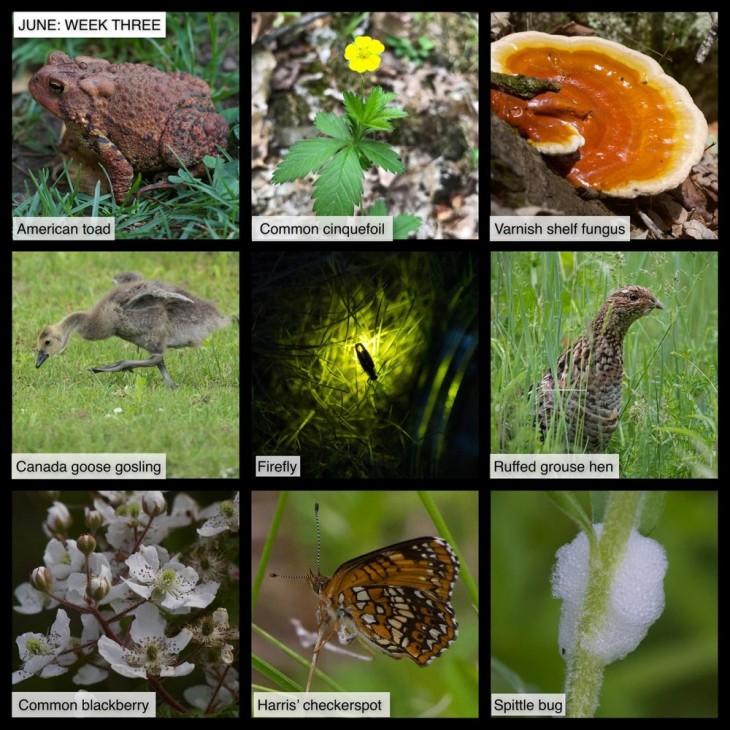This week in the woods, and lawns, and perhaps in your garden, American toads are on the hop, hunting nighttime insects. Although most are predominantly brown or gray, some are more orange. Whatever its hue, a toad’s skin is laden with poisons that can sicken or even kill a predator. Here’s an Outside Story describing toads’ impressive chemical defenses, and a link to a National Wildlife Federation article, explaining how and why (10,000 insects a summer?!) to “dote on toads.”
Common cinquefoil, a member of the rose family, is blooming now in sunny woods. Look for its heart shaped petals. Here’s a profile of the plant, which is favored by pollinators.
Varnish shelf fungus, also known as reishi, grows all year round, but for whatever reason, we’ve noticed several specimens recently. It’s (probably) closely related to Lingzhi, a fungus prized in ancient China for medicinal properties. Here’s a profile of varnish shelf (which is more than one species) from the UNC Press Blog.
By this late in June, many broods of Canada geese are growing out of their cute baby bird phase and becoming awkward adolescents. The mother of this gosling was proudly sporting a migratory bird leg band, but you don’t have to go very far south to find geese that have given up on long-distance travel for a life of ease on the golf course. Here’s an article by Bryan Pfeiffer that explains the modern phenomenon of resident geese, and how they became established (spoiler: it’s humans’ fault).
Fireflies have shown up in ones and twos for the past couple of weeks, but last Friday they appeared by the dazzling field full. There are multiple species, and according to Sarah Lewis in this 2017 article, “it’s the timing of a male’s flash, rather than its color or shape, which conveys the crucial information about his species identity and sex.” Be sure to check out the remarkable stacked photo of firefly light.
This ruffed grouse hen was accompanied by young chicks (hidden in this photo by tall grass). As noted in this profile by the Ruffed Grouse Society, chicks are precocial and remarkably tough. They can travel ¼ a mile by day by the time they are three or four days old, and can fly in only about five days. Mom’s tough, too. Here’s a description by Mary Holland, of her experience being charged by a protective hen.
On pretty much any disturbed site – a patch cut, log landing, or scarified field – common blackberries appear. They’re blooming now, to the delight of bees and other pollinators. Here’s an article by Rachel (Sargent) Mirus that shares interesting facts about the plant, including some tips on how to distinguish it from black raspberries.
More butterflies have appeared over the past several days, but most of them have been notably uncooperative about posing for a photograph. Not so this Harris’ checkerspot, which was even kind enough to open its wings at different angles so we could confirm its identity. These butterflies – relatively small, with a 1 ½ inch or so wingspan – often feed on vetches. According to Larry Weber, in Butterflies of New England, they have only one brood per summer and butterflies will only be active from now until July. Here’s a bit more about them from the Massachusetts Butterfly Club, including a look at their caterpillar.
Spittle bugs also showed up in force this week – maybe they had an agreement with the fireflies? Here’s an Outside Story article by Li Shen about the tiny bugs (also called froghoppers), which includes this child-thrilling information: “despite its name, spittle bug ‘spit’ isn’t spit at all, but comes from the other end of the bug.” And here’s a close-up photograph of the insect.
In this difficult period, many of us find joy in observing local nature, and many families are seeking outdoor enrichment opportunities for children. Here are nine photographs taken this past week in forests within 15 miles of the Northern Woodlands office in Lyme, New Hampshire. We hope you enjoy using this grid as a prompt for your own explorations, or as the basis for a game of family forest tic-tac-toe.
What are you seeing in the woods this week? Share your images with us on Facebook, or submit a special photo for possible inclusion in our monthly online Reader Photo Gallery.


